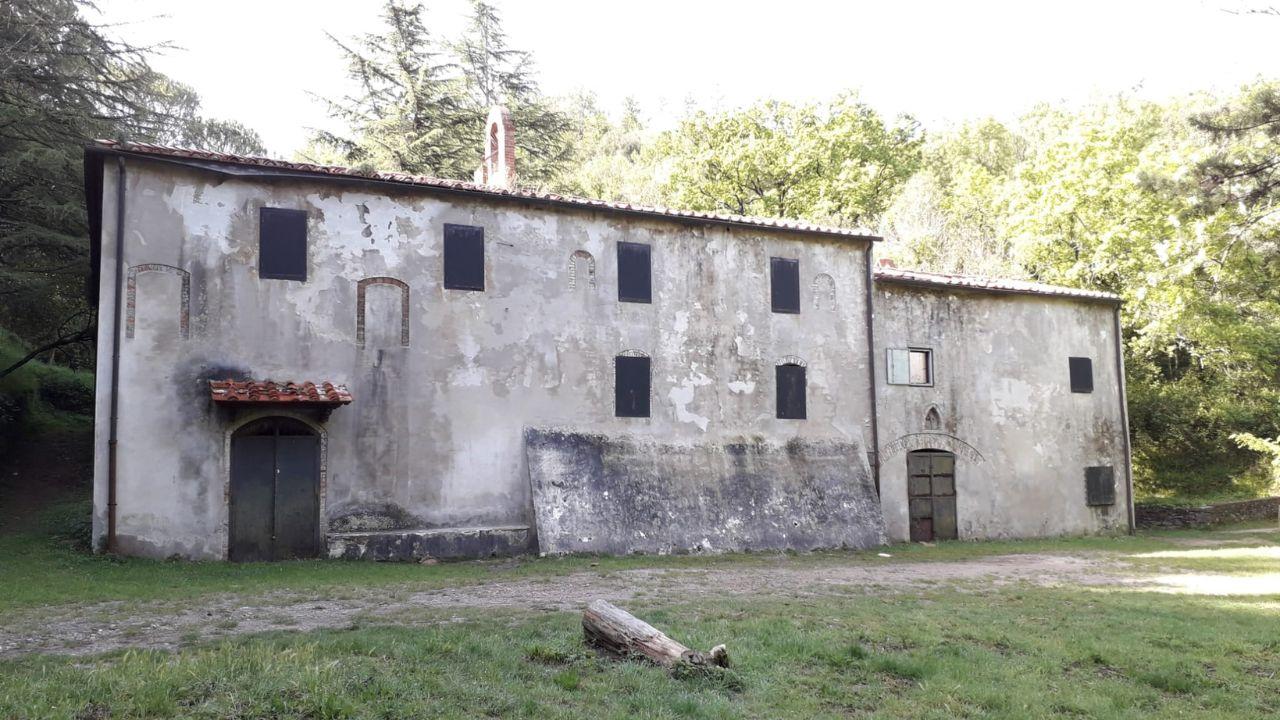IL PASSATO E’ VITA, IL PRESENTE E’ ATTESA, MA IL FUTURO E’ MORTE CERTA, QUINDI SALVIAMO L’EREMO E LA SUA FENICE
In questo post avrei dovuto continuare a parlare della cappella di Villa Huygens e delle sue reliquie perdute. Perdute come è perduta la grande scalinata di Villa Limone ex pieve di Sant’Andrea a Limone. Ma il contributo dell’emblematico Martin Tower suggerisce di tralasciare momentaneamente queste celebri Ville per occuparci dell’ancor più celebre Eremo della Sambuca.
Dalla fine della seconda guerra mondiale, le varie arciconfraternite si sono impegnate per convincere le autorità predisposte alla tutela del monastero a “salvare” l’Eremo della Sambuca. Dal momento che all’interno trova spazio la sala della Fenice, dove ancora oggi è visibile il suo affresco collocato sopra una pila. Questa ancestrale sala sta correndo un serio pericolo, dato che il tetto sovrastante è crollato, permettendo all’acqua di infiltrarsi, la pioggia farà crollare pure il soffitto della sala e le macerie si abbatteranno sulla Fenice e sulla sua pila. Da tale pila in passato, una sola volta l’anno, sgorgava un rigolo d’acqua che se raccolta in un particolare calice poteva essere bevuta per far rinascere come una Fenice. Il calice in questione, come ormai è risaputo, fu portato dai templari che sbarcarono sulle coste livornesi. Quando il calice fu tolto dall’elmo in cui era “incastrato” (di questo particolare ne parlerò nel prossimo post), fu mostrato ai monaci agostiniani di San Jacopo, che subito ne chiesero il possesso, ma Roberto da Volterra rifiutò la richiesta, inoltre, per dimostrare la sua gratitudine al gigante Limoncino per l’aiuto ricevuto, volle portare il calice presso la Pieve del Limone. Roberto stesso, seguito dai suoi Templari, portò il calice fino in cima alla grande scalinata dove il gigante troneggiava. Per un certo periodo il calice fu ubicato in una teca che si trovava alla sommità della scalinata, ma una serie di eventi catastrofici causò la scomparsa del gigante, della scalinata e della sua pieve, ma prima che questo accadesse, Roberto da Volterra affidò il calice agli ultimi Eremiti Neri, stanziati presso il Monastero della Poggia, conosciuto come il “Conventaccio”. Ben presto pure il Conventaccio e gli Eremiti Neri subirono stessa sorte. Il calice, quindi, dopo varie traversie, fu preso in consegna dai religiosi dell’Eremo della Sambuca. Essi intuirono immediatamente quali poteri possedesse tale calice, per questo fu rinominato come “la sacra coppa della Sambuca”. Sacra, ma piuttosto fragile, infatti si potevano notare alcune piccole incrinature. Questo portò i religiosi alla drastica decisione di dotare la coppa di una protezione avvolgente in metallo. In principio tentarono da soli usando del piombo, ma senza risultato. Allora pensarono di utilizzare assieme rame e smalto, ma viste le difficoltà nel maneggiare un crogiolo con maestria, decisero di inviare il manufatto da dei veri professionisti. La coppa fu inviata a Siena nella bottega orafa della scuola appartenuta ad Andrea di Petruccio Campagnini, ove, oltre al rivestimento, venne prodotta pure una copia, talmente somigliante che riconoscerle diventava molto difficile, ma questa è una storia già narrata…. Ma non del tutto ancora capita! To be continued.
English version
THE PAST IS LIFE, THE PRESENT IS WAITING, BUT THE FUTURE IS CERTAIN DEATH, SO LET'S SAVE THE HERMITAGE AND ITS PHOENIX
In this post I should have continued to talk about the Villa Huygens chapel and its lost relics. Lost as the great staircase of Villa Limone formerly the parish church of St. Andrew in Limone is lost. But the contribution of the emblematic Martin Tower suggests that we momentarily leave out these famous Villas to deal with the even more famous Sambuca Hermitage.
Since the end of World War II, the various archconfraternities have been working to convince the authorities predisposed to protect the monastery to “save” the Sambuca Hermitage. Since the Phoenix Hall is located inside, where its fresco placed on top of a stack is still visible today. This ancestral hall is in serious danger, since the roof above has collapsed, allowing water to seep in; rain will cause the ceiling of the hall to collapse as well, and the rubble will fall on the Phoenix and its stack. From that stack in the past, only once a year, a trickle of water gushed forth that if collected in a particular chalice could be drunk to be reborn as a Phoenix. The chalice in question, as is now well known, was brought by the Templars who landed on the shores of Livorno. When the chalice was taken out of the helmet in which it was “embedded” (I will discuss this detail in the next post), it was shown to the Augustinian monks of San Jacopo, who immediately asked for its possession, but Robert of Volterra refused the request; moreover, to show his gratitude to the giant Limoncino for the help he had received, he wanted to take the chalice to the Pieve del Limone. Robert himself, followed by his Templars, carried the chalice to the top of the great staircase where the giant towered. For a time the chalice was located in a shrine that stood at the top of the staircase, but a series of catastrophic events caused the disappearance of the giant, the staircase and its parish church, but before this happened, Robert of Volterra entrusted the chalice to the last Black Hermits, stationed at the Monastery of the Poggia, known as the “Conventaccio.” Soon the Conventaccio and the Black Hermits also suffered the same fate. The chalice, then, after various travails, was taken over by the religious of the Sambuca Hermitage. They immediately sensed what powers such a chalice possessed, which is why it was renamed as “the sacred cup of Sambuca.” Sacred, but rather fragile, in fact some small cracks could be seen. This led the religious to the drastic decision to equip the cup with a metal wrap-around protection. At first they tried on their own using lead, but to no avail. Then they thought of using copper and enamel together. But given the difficulties in handling a crucible skillfully, they decided to send the artifact to real professionals. The cup was sent to Siena to the goldsmith's workshop of the school that belonged to Andrea di Petruccio Campagnini, where, in addition to the casing, a copy was also produced, so similar that recognizing them became very difficult, but this is a story already told.... But not entirely understood yet! To be continued.


